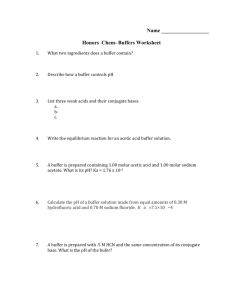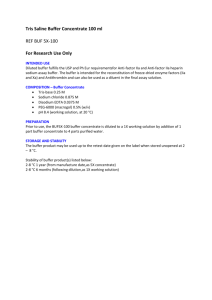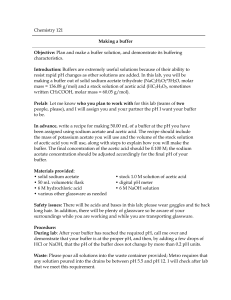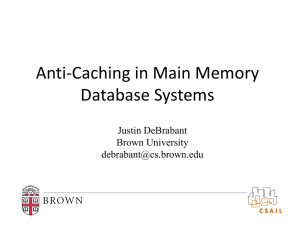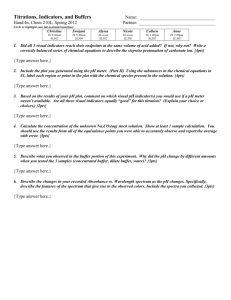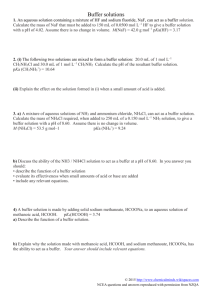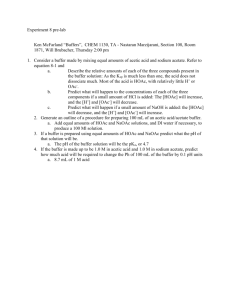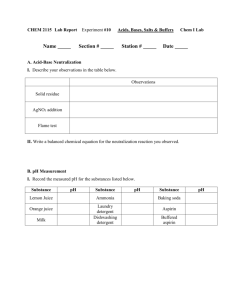APPENDICES - Charlotte
advertisement
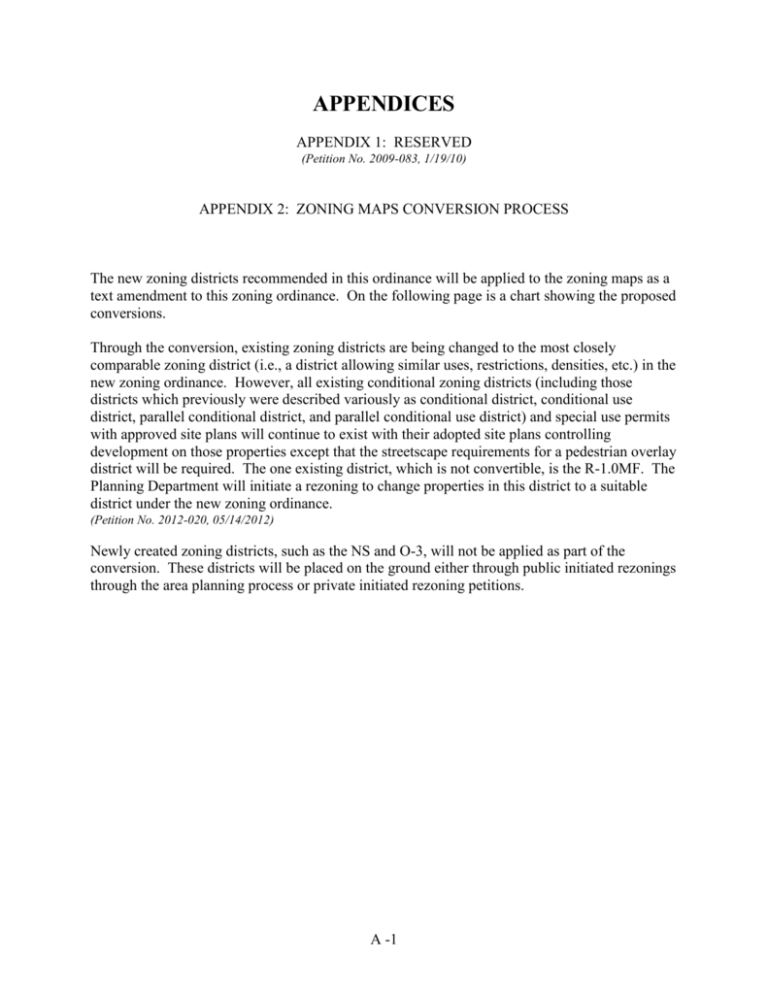
APPENDICES APPENDIX 1: RESERVED (Petition No. 2009-083, 1/19/10) APPENDIX 2: ZONING MAPS CONVERSION PROCESS The new zoning districts recommended in this ordinance will be applied to the zoning maps as a text amendment to this zoning ordinance. On the following page is a chart showing the proposed conversions. Through the conversion, existing zoning districts are being changed to the most closely comparable zoning district (i.e., a district allowing similar uses, restrictions, densities, etc.) in the new zoning ordinance. However, all existing conditional zoning districts (including those districts which previously were described variously as conditional district, conditional use district, parallel conditional district, and parallel conditional use district) and special use permits with approved site plans will continue to exist with their adopted site plans controlling development on those properties except that the streetscape requirements for a pedestrian overlay district will be required. The one existing district, which is not convertible, is the R-1.0MF. The Planning Department will initiate a rezoning to change properties in this district to a suitable district under the new zoning ordinance. (Petition No. 2012-020, 05/14/2012) Newly created zoning districts, such as the NS and O-3, will not be applied as part of the conversion. These districts will be placed on the ground either through public initiated rezonings through the area planning process or private initiated rezoning petitions. A -1 ZONING MAPS CONVERSION Existing Districts New Districts RU R-15 R-12 R-9 --R-6 ----R-R R-20MF wo/Site Plans R-15MF R-12MF R-9MF R-6MF R-6MFH RE-1 RE-2 Inst O-15 O-9 O-6 --B-1 B-2 B-D UI I-1 I-2 I-3 R-3 R-3 R-3 R-4 --R-5 R-6 R-8 R-5 R-8MF R-12MF R-17MF R-17MF R-22MF R-43MF RE-1 RE-2 Inst O-1 O-2 O-2 O-3 B-1 B-2 B-D UI I-1 I-2 I-2 HD ------- HD-O (Historic District) A-O (Airport) C-O (Corridor) MH-O (Manufactured Home) ----------BP ----UDC-V MX-1 MX-2 MX-3 R-MH CC BP NS HW --- R-MH R-20MF Innovative R-20MF w/Site Plans Continue * (Also, See Special Purpose Districts) Continue * Continue * R-I R-PUD Continue * Continue * A -2 ZONING MAPS CONVERSION (Continued) * Existing Districts New Districts B-1SCD Special Use Permits Parallel Conditional Use Districts Continue * Continue * Continue * Development of these uses will be governed by the previously approved site plans. The new ordinance shall not be applicable or enforced without the consent of the owner with regard to uses previously approved under a conditional zoning district (including those districts which previously were described variously as conditional district, conditional use district, parallel conditional district, and parallel conditional use district) and special use permits with approved site plans will continue to exist with their adopted site plans controlling development on those properties except that the streetscape requirements for a pedestrian overlay district will be required. Any substantial amendments to these approved uses will be subject to the requirements of the new ordinance. Notes: (1) New districts which do not have a reasonable equivalent existing district (e.g. R-3 and R-8) will not be established through the zoning map conversion process. In order to establish these districts, an individual or the government would have to petition for a reclassification of property to these new districts. (2) Rezoning of the R-1.OMF will involve only one parcel of land. A-3 APPENDIX 3: NORTH CAROLINA GENERAL STATUTE ARTICLE 26A. Adult Establishments Sec. 14-202.10. Definitions. As used in this Article: (1) "Adult bookstore" means a bookstore: a. Which receives a majority of its gross income during any calendar month from the sale of publications (including books, magazines, and other periodicals) which are distinguished or characterized by their emphasis on matter depicting, describing, or relating to specified sexual activities or specified anatomical areas, as defined in this section; or b. Having as a preponderance of its publications books, magazines, and other periodicals, which are distinguished or characterized by their emphasis on matter depicting, describing, or relating to specified sexual activities or specified anatomical areas, as defined in this section. (2) "Adult establishment" means an adult bookstore, adult motion picture theatre, adult mini motion picture theatre, adult live entertainment business, or massage business as defined in this section. (3) "Adult live entertainment" means any performance of or involving the actual presence of real people which exhibits specified sexual activities or specified anatomical areas, as defined in this section. (4) "Adult live entertainment business" means any establishment or business wherein adult live entertainment is shown for observation by patrons. (5) "Adult motion picture theatre" means an enclosed building or premises used for presenting motion pictures, a preponderance of which are distinguished or characterized by an emphasis on matter depicting, describing, or relating to specified sexual activities or specified anatomical areas, as defined in this section, for observation by patrons therein. "Adult motion picture theatre" does not include any adult mini motion picture theatre as defined in this section. A-4 (6) "Adult mini motion picture theatre" means an enclosed building with viewing booths designed to hold patrons which is used for presenting motion pictures, a preponderance of which are distinguished or characterized by an emphasis on matter depicting, describing or relating to specified sexual activities or specified anatomical areas as defined in this section, for observation by patrons therein. (7) "Massage" means the manipulation of body muscle or tissue by rubbing, stroking, kneading, or tapping, by hand or mechanical device. (8) "Massage business" means any establishment or business wherein massage is practiced, including establishments commonly known as health clubs, physical culture studios, massage studios, or massage parlors. (9) "Sexually oriented devices" means without limitation any artifical or simulated specified anatomical area or other device or paraphernalia that is designed principally for specified sexual activities but shall not mean any contraceptive device. (10) "Specified anatomical areas: means: (11) a. Less than completely and opaquely covered: (i) human genitals, pubic region, (ii) buttock, or (iii) female breast below a point immediately above the top of the areola; or b. Human male genitals in a discernibly turgid state, even if completely and opaquely covered. "Specified sexual activities" means: a. Human genitals in a state of sexual stimulation or arousal: b. Acts of human masturbation, sexual intercourse or sodomy; or c. Fondling or other erotic touchings of human genitals, pubic regions, buttocks or femal breasts. (1977, c. 987, s. 1; 1985, c. 731. s. 1.) A-5 APPENDIX 4: AMENDMENTS The following amendments have occurred since this printing. A-6 APPENDIX 5 WATERSHED BUFFER GUIDELINES for MECKLENBURG COUNTY, NC Revised: July, 1998 ENVIRONMENTAL MANAGEMENT DIVISION WATER QUALITY SECTION A-7 700 NORTH TRYON STREET CHARLOTTE, NORTH CAROLINA 28202-2236 A-7 TABLE OF CONTENTS I. General Requirements and Prohibitions...................................................... 1 II. Maintenance of Existing Buffer Vegetation.................................................. 3 III. Planting New/Additional Vegetation in Buffer.............................................. 5 IV. Vegetation In The Buffer................................................................................. 5 Appendix A: Sample Buffer Plan……….......................................................................... 9 Appendix B: Subdivision Plan Requirements For Buffers......................................…... 10 For more information concerning buffers or general watershed protection, please call the Water Quality Section of the Mecklenburg County Department of Environmental Protection at (704) 3365500. A-8 MECKLENBURG COUNTY, NORTH CAROLINA WATERSHED BUFFER GUIDELINES Mecklenburg County, the City of Charlotte and the Towns of Cornelius and Huntersville subdivision and zoning ordinances require water quality protection buffers for the county's regulated water supply watersheds. These ordinances further require the Mecklenburg County Department of Environmental Protection (MCDEP) to develop guidelines and approve plans for any activities that would disturb the buffers. The Watershed Buffer Guidelines for Mecklenburg County (Guidelines) fulfill that requirement setting forth minimum desirable standards and will be used on a case by case basis to direct plan approval. (Note: The zoning and subdivision ordinances of Davidson require buffers but do not reference these guidelines.) Plans will be required under the ordinances in the following situations to include but not limited to: 1) when streambank or shoreline stabilization is proposed; 2) when removal of existing trees is proposed for access to the lake or stream; 3) during new development or the expansion of existing development if the buffer requires enhancement; 4) when any disturbance of existing vegetation is proposed within the buffer; and 5) when any land disturbance occurs within the buffer (i.e. grading, filling, soil tilling, etc.). Plan approval will be based on the direct application of these Guidelines as appropriate and on the ability of the buffer to protect water quality as explained in the purpose statement. Purpose: The primary intent of these Guidelines is to maintain or establish and maintain an effective, natural, forested, low maintenance ecosystem, which will function as described below. Watershed buffers are undeveloped areas between perennial streams or lakes, and development. These buffers serve a specific purpose of reducing the volume of runoff, thereby reducing erosion and pollutants coming from an area of more intensive land use to a waterbody. The reduction of erosion and pollutants occurs through natural mechanisms such as deposition, infiltration, adsorption, filtration and decomposition. Natural forested areas have the best capacity for collecting and storing nutrients and other pollutants. The tree canopy also protects the soil from erosion and provides shading, which can reduce water temperatures and enhance aquatic habitats. (Shallow rooted grasses requiring ongoing maintenance do not fulfill this purpose.) I. GENERAL REQUIREMENTS AND PROHIBITIONS 1. Applicability a. Mountain Island Lake: These guidelines are applicable to property in the Mountain Island Lake watershed as defined in the applicable local subdivision ordinances as follows: i. All new subdivisions of land with property adjacent to the lake or a perennial stream, approved in Mecklenburg County after March 8, 1993, in Charlotte after June 21, 1993, in Cornelius after September 20, 1993 and in Huntersville after October 1,1993, 1 ii. unless prior approval had been granted as specified in the applicable subdivision ordinances (i.e. "they have been grandfathered"). All new or improved lots adjacent to the lake or a perennial stream in Mecklenburg County and Charlotte, commencing construction after June 21, 1993, in Cornelius after September 20, 1993, and in Huntersville after October 1, 1993, unless prior approval had been granted as specified in the applicable zoning ordinances (i.e. "they have been grandfathered"). b. Lake Norman: These guidelines are applicable to property in the Lake Norman watershed as defined in the applicable local subdivision ordinances as follows: i. ii. iii. All new subdivisions of land with property adjacent to the lake or a perennial stream, approved in Mecklenburg County after June 6, 1994, and in Cornelius after September 20, 1993, unless prior approval had been granted as specified in the applicable subdivision ordinances (i.e. "they have been grandfathered"). All new or improved lots adjacent to the lake or a perennial stream in Mecklenburg County commencing construction after June 6, 1994, and in Cornelius after September 20, 1993, unless prior approval had been granted as specified in the applicable zoning ordinances (i.e. "they have been grandfathered"). For buffer guidance in the portion of the watershed under the jurisdiction of the Town of Davidson, refer to its local zoning and subdivision ordinances, which became effective October 1, 1993. c. Lake Wylie: These guidelines are applicable to property in the Lake Wylie watershed as defined in the applicable local subdivision ordinances as follows: i. ii. All new subdivisions of land with property adjacent to the lake or a perennial stream, approved in Mecklenburg County after June 20, 1994, and in Charlotte after June 21, 1993, unless prior approval had been granted as specified in the applicable subdivision ordinances (i.e. "they have been grandfathered"). All new or improved lots adjacent to the lake or a perennial stream in Mecklenburg County commencing construction after June 20, 1994, and in Charlotte after June 21, 1993, unless prior approval had been granted as specified in the applicable zoning ordinances (i.e. "they have been grandfathered"). 2. Requirements/Allowances a. When a site-specific buffer plan is needed, (required or voluntary enhancement) each subdivision or lot shall provide to MCDEP a plan for approval. Plans shall be submitted individually or in conjunction with erosion control and/or subdivision/building review plans. A Sample Site Specific Buffer Plan is provided in Appendix A. b. Slope shall be addressed in each individual buffer plan as to the number and density of tree cover and other plant material in order to adequately protect the shoreline. In general, the steeper the slope grade, the greater the density of trees and vegetation required to control the runoff. All erosion control devices should be located along the upland side of the buffer. To address any erosion caused by the construction of accessways or shoreline stabilization, temporary erosion control measures may occur in the buffer with approval from MCDEP. c. If concentrated flow from a subdivision or a lot begins above a buffer, it should be dispersed 2 as it flows into the buffer to promote shallow and uniform flow. Storm water ditches and pipes shall stop prior to the buffer allowing water to sheet flow across the buffer thus minimizing channelization of storm water flow. d. Shoreline stabilization is allowed as long as minimal disturbance of the existing buffer occurs. Other required permits for shoreline maintenance, dredging or filling, and dock construction (401/404 State permits, Duke Power, Land Use and Environmental Services Agency) need to be obtained prior to construction. (Petition No. 2005-78, §Appendix 5(2)(d), 06/20/05) e. Land clearing is allowed on a limited, conditional basis as explained under “Maintenance of Existing Buffer Vegetation” #3 on page 4. f. Openings to provide access to the lake and dock areas are allowed, but are limited to a maximum width of 10 feet for boats and 6 feet for walkways. Access to streams is limited to a maximum width of 6 feet for walkways. Pervious materials should be used as base material or elevated boardwalks can be used. Paths should be constructed to effectively control runoff and erosion. Where slopes exceed 15%, lake or stream access methods must receive prior approval, unless they are above ground (boardwalks). g. Temporary disturbances of the buffer are allowed with prior approval from MCDEP and shall be evaluated on a case-by-case basis taking into consideration the primary intent of these Guidelines. h. Utility right-of-ways are allowed in the buffer provided they are re-vegetated in accordance with these Guidelines. i. Pumps for irrigation are allowed in the buffer provided they are electrically operated. No gasoline engines are allowed. 3. Prohibitions a. Turf grass, as a permanent landscape feature, is not permitted within the buffer. Turf grass used for temporary erosion control measures as part of an approved plan is allowable (e.g. rye). b. Impervious structures such as driveways and boathouses on land are not permitted within the buffer. c. Septic tanks, drain fields and repair areas are not permitted within the buffer. Repairs to existing septic systems, that involve no increase in capacity, shall be considered on a case-bycase basis. d. Structural best management practices are not allowed in the buffer. e. Clearing or grading within the buffer is not allowed. If the existing buffer is disturbed in any way, the buffer must be replanted in accordance with these Guidelines. II. MAINTENANCE OF EXISTING BUFFER VEGETATION 1. Ground cover Existing, trees, shrubs, ground covers, natural grasses or perennials should be left in place. Where there is not enough vegetation to control runoff and erosion, a mulch cover of 2-inch minimum depth should be maintained over the entire buffer area. This should be, whenever possible, made up of natural leaf litter as is typically found in an undisturbed wooded area. Where this natural 3 litter is not present at a sufficient depth, it should be supplemented with natural organic mulch such as leaves, leaf mold, wood chips, tree bark or pine needles. Removal of natural leaf fall from within the buffer is prohibited as natural leaf litter provides beneficial results such as enriching the soil, protecting tree roots and absorbing water runoff. Perennial ground cover as specified under “VEGETATION IN THE BUFFER” Section 4 on page 5 can be used in place of mulch as approved by MCDEP. 2. Existing Tree Cover Except as otherwise provided in these Guidelines, existing tree cover should be retained at a minimum density of at least 12 healthy trees of a minimum 6 inch caliper per 1000 square feet of buffer area. This minimum tree density should be more or less uniformly distributed over the entire buffer area with the exception of approved openings. Pruning of trees within the buffer will be limited to the removal of only lateral limbs from no more than the lower 50 percent of the tree’s total height. Topping is not allowed. The Subdivision Ordinances state that "No trees larger than 2 inch caliper are to be removed except for dead or diseased trees." Combinations of larger and smaller trees can also provide an effective buffer. For example, where an adequate density of natural tree cover exists, but there are too few trees of the minimum 6 inch diameter size class, then two trees of at least a 1 1/2 inch caliper may be counted for each deficiency of a larger tree. (As an example, if a buffer contained 2500 square feet, the normal standard would be a minimum of 30, six-inch trees. If the buffer had only 10 trees over six inches and the rest were smaller, then the standard would be met with the 10 six inch trees and 40 (2x20) trees above 1 1/2 inches in caliper.) 3. Land Clearing The removal of some native vines, shrubs, ground covers and small trees to facilitate a better view or a more aesthetically pleasing natural landscape may be allowed. This thinning operation must be done with hand tools and/or minimal use of approved herbicides. No grubbing of tree stumps is allowed; however, their removal with a stump grinding machine, which causes minimal soil disturbance, is allowed. Natural leaf litter, humus and soil should remain. 4. Exceptions i. Some tree thinning may be permissible with approval where thick cover exists and it is desirable to promote a healthy tree cover and produce the most effective buffer. ii. The minimum desired tree density standard may be reduced in order to reduce crowding to below 12 trees per 1000 square feet, if the buffer contains a majority of large diameter trees. For every three trees that have a diameter at chest height of over 12 inches, the total number of trees desired within the buffer is reduced by one tree. As an example, if a buffer is 2500 square feet, it should contain a minimum of 30 healthy trees of a minimum six-inch diameter. Should 15 of these trees be 12 inches in diameter or above, then the minimum desired standard would drop to 25 trees with the lower density being found in the area where the larger trees were predominant. 4 III. PLANTING NEW/ADDITIONAL VEGETATION IN THE BUFFER 1. New or Enhanced Tree Cover In areas of the buffer where the density of trees is less than the minimum, it is desirable to plant new trees. Where new or replacement trees are installed to satisfy the minimum standards set forth in these Guidelines, they should be planted to a density of 12 trees per 1000 square feet and have a minimum caliper of 1 1/4 inches measured at 6 inches above the rootball. Equivalent combinations of permanent tree, shrubs and ground covers may be substituted following MCDEP’s approval of a buffer plan (see Appendix A). 2. Shrubs and Ground covers Planting of additional shrubs, ground covers and perennials may be approved if done so with minimal disturbance to root systems of existing trees. Addition of nutrients (fertilizers) into these buffer areas is prohibited except at planting time when mixing nutrients and soil amendments with the backfill soil is acceptable. IV. VEGETATION IN THE BUFFER 1. Benefits of a Vegetated Buffer A healthy vegetative cover within the buffer area can provide a stable land surface, which absorbs rainfall, cuts down on heat reflectance and noise, and absorbs pollutants washing across the land. Dense, vigorous vegetation protects the soil from raindrop impact, a major force in dislodging soil particles and moving them down slope. The shielding effect of a plant canopy is augmented by roots and rhizomes that hold the soil, improve its physical condition, and increase the rate of infiltration. Plants also reduce the moisture content of soil through transpiration, thus increasing its capacity to absorb water. Undisturbed buffer areas can provide low-maintenance landscaping, shade, and privacy screening. Large trees and carefully designed buffers may dramatically increase property value. 2. Site Considerations Species selection should be based on site characteristics including soils, slope, aspect, climate, and expected management of that area. a. Soils: Piedmont soils are generally low in organic matter and have subsoils high in clay. Deeper subsoils are typically silts, silt loams, and sandy loams. Surface soils vary from sandy loam to clay loam, and subsoils are commonly thick with heavy clay texture. Topography is mostly rolling hills with well-developed drainage patterns. Piedmont soils generally support a wide variety of plants, including both cool and warm season species. b. Slope: Slope describes the degree of steepness of the topography on a parcel of land. The steeper the slope, the more essential is a vigorous vegetative cover. This vigorous vegetative cover will help protect accelerated runoff due to the steep slope by slowing down the velocity of the water running across that surface. 5 c. Aspect: Aspect is the actual direction in which the property or specific site faces. Aspect affects soil temperature and available soil moisture. South and West facing slopes tend to be warmer and drier, while North and East facing slopes tend to be cooler and more moist. On South and West facing slopes, mulch is essential to retain moisture and drought tolerant species are recommended. South and West facing slopes may also be subject to occasional frost heaving due to repeated cycles of freezing and thawing. d. Climate: The regional climate must be considered when selecting well-adapted species. Climatic differences determine the appropriate plant selections based on such factors as cold hardiness, tolerance to high temperatures and high humidity, and resistance to insects and disease. Mecklenburg County lies in the southern Piedmont region of the Carolinas, situated between the Coastal Plain to the east and the Foothills and Mountains to the West. Winter temperatures in the southern Piedmont average 47 degrees. The average low is 30 degrees with temperatures sometimes dropping below 0 degrees. The average summer temperature is 70 degrees. The average high is 87 degrees and sometimes tops 100 degrees. The southern Piedmont region receives an average of about 45 inches of rainfall annually with the majority of rain occurring during the late winter and spring months. Drought conditions may occur during the summer months and must be considered when selecting appropriate species for buffer area planting. e. Management: Buffer areas should be established for low to no maintenance. Effective buffers should mimic as closely as possible true natural conditions. Native plants or species that are well adapted to this region should be selected. Longevity of a species is an important consideration, as well as resistance to disease, drought, infestations from pests, etc. Plant species selected should also require no fertilization on a regular basis. 3. Approved Plants for Watershed Buffers The following species lists are approved for the Carolinas region in general and need to be matched with local site conditions. This species list is not considered comprehensive and variations from these lists may be permitted with prior approval from MCDEP. The criteria discussed above will be used when determining non-listed species for buffer suitability. a. Native Trees for Buffer Area Planting Ailanthus Arborvitae Ash - Green, White Bald Cypress Basswood Beech Birch - River, Sweet, Yellow Blackgum Black Walnut Box Elder Buckeye Catalpa Cedar - Eastern Red, Atlantic White Cherry - Black, Red Chinese Chestnut 6 Cottonwood - Eastern Dogwood Elm - Slippery, Winged (Not American due to Dutch Elm disease) Hawthorn Hackberry Hemlock Hickory - Bitternut, Shagbark, Mockernut, Pignut Holly Hop-Hornbeam Locust - Honey, Black Magnolia Maple - Sugar, Silver, Red Mulberry Oak - White, Post, Chestnut, Live, N.Red, S.Red, Cherrybark, Black, Willow, Scarlet, Water, Pin Persimmon Pine - Shortleaf, Loblolly, Virginia, Longleaf, White Poplar - Yellow Redbud Sassafras Service Berry Silverbell Sourwood Sweetgum Sycamore Willow - Black, Weeping Witch-hazel Ferns b. Native Shrubs for Buffer Area Planting Alder American Elder (Elderberry) Arnot Bristly Locust Autum Olive Azalea Bankers Dwarf Willow Bayberry Beauty berry Blackberry Blueberry Buttonbush Chinquapin Choke berry Crape Myrtle Dogwoods - Rodosier, Greystem, Silky, Red Twig Fetterbush Groundsel tree Holly - Dwarf Inkberry, Gallberry, Winterberry Horsesugar Huckleberry Indigo Bush 7 Lespedeza Meadowsweet Mimosa Mountain Laurel Paw Paw Pepperbush Privet Purpleosier Willow Rhododendron Rose Snowbell Spicebush Strawberrybush Sumac (non-poisonous) Sweet Fern Viburnum Wax Myrtle Winter Jasmine Yaupon c. Ground Cover for Buffer Area Planting Bearberry Bigleaf Winter Creeper Daylily English Ivy Honeysuckle Juniper Pachysandra Periwinkle St. Johnswort Virginia Creeper d. Non-Turf Grasses for Buffer Area Planting Bluestem - Big, Little Broomsedges Deertongue Indiangrass Ironweed Jerusalem Artichoke Joe Pye Weed Liriope Swamp Milkweed Switchgrasses Species list compiled by MCDEP Water Quality staff with assistance from Mecklenburg County Storm Water Services, Mecklenburg County Cooperative Extension Service, Mecklenburg County Soil and Water Conservation District, and the City of Charlotte Landscape Management Division. 8 APPENDIX A: WATERSHED BUFFER GUIDELINE APPENDIX A SAMPLE BUFFER PLAN July 29, 1998 Specifications Which Must Be Included In The Buffer Plan: All plant species to be placed in the buffer must be identified. The distances between the different plantings must be specified. All plantings must comply with the “Watershed Buffer Guidelines for Mecklenburg County, NC” Section III entitled Planting New/Additional Vegetation In Buffer which is located on page 5. All plantings should be of a variety specified in the “Watershed Buffer Guidelines for Mecklenburg County, NC” Section IV entitled Vegetation In The Buffer which is located on pages 5 through 8. Mulch should be specified at a minimum depth of 2 inches. 9 APPENDIX B: WATERSHED BUFFER GUIDELINE APPENDIX B SUBDIVISION PLAN REQUIREMENTS FOR BUFFERS July 29, 1998 A separate Buffer Plan must be included in the Subdivision Plan package. It should be listed on the Master Plan’s index as Buffer Plan. The Buffer Plan must contain the following: 1. The entire buffer area clearly marked or shaded. 2. The point from which the buffer was measured. 3. Any activity or disturbance in the buffer should be identified and “blown up” on the Buffer Plan. Specific details should be given on pathways, boardwalks, boat ramps, etc. 4. If a disturbance is proposed in the buffer (such as a boat ramp or sewer line ROW), a restoration plan showing replantings should be included as part of the Buffer Plan. The restoration should follow the guidelines stated in the Watershed Buffer Guidelines for Mecklenburg County, NC. Specifics should be stated such as tree/ bush types and planting densities. The Buffer Plan MUST CLEARLY STATE the following: 1. No disturbance whatsoever is allowed in the buffer. 2. No sediment basins, open channels, or piped storm water is allowed in or through the buffer. Drainage areas should be designed to allow water to sheet flow across the buffer to filter out pollutants. Plunge pools, level spreaders, diversion devices or wetland flow should be used to provide this sheet flow. 3. No heavy equipment is allowed in the buffer. 4. The buffer will be clearly marked by flagging or fencing prior to any construction at the site. 5. Any activity in the buffer will comply with the Watershed Buffer Guidelines for Mecklenburg County, NC. 6. The Mecklenburg County Department of Environmental Protection (MCDEP) will be notified of any changes to the approved Buffer Plan. 7. The buffer will be permanently marked on each individual lot using iron stakes in concrete. 10 8. Buffer restrictions will be placed on each individual deed. 9. Educational materials concerning the buffer will be distributed to each homeowner and builder prior to construction or occupancy. 10. All sub contractors will be notified of the buffer regulations prior to development. 11. MCDEP will be notified following the completion of construction activities in order that an inspection of the buffer can be performed. Certificates of Occupancy will not be released until MCDEP has verified that the buffer complies with all applicable ordinances and guidelines. 11

